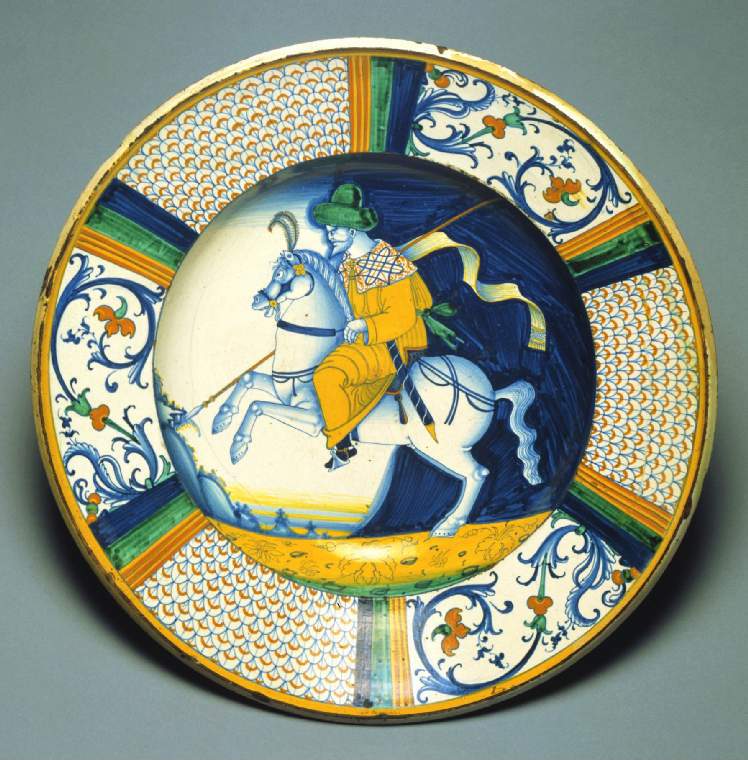Current Location: Gallery 7 (Courtauld)
Titles
Dish: a Turkish Lancer
Maker(s)
Pottery:
Mancini Workshop
(Possibly)
Entities
Categories
Description
Dark buff earthenware, the front tin-glazed; the reverse probably slip-coated or tin-glazed before application of honey-yellow lead glaze. Painted in dark blue, green, yellow, and orange.
Shape 61. Circular with sloping rim, upturned at the edge and wide deep well, standing on a footring in which there are two holes for suspension at the top.
In the well, a mounted Turkish lancer gallops to the left. He wears a high-crowned turban and a long gown with a wide falling collar. A scarf or pennant streams out behind him. The landscape background has a low horizon, and the right half of the sky is dark blue and the left half is white. The rim is divided by radial stripes into six panels containing alternately scale pattern and a foliate scroll with formal flowers and fruits. A yellow band encircles the edge. On the back, inside the footring, there is a blue zigzag resembling an M or W with an extra stroke, crossed by a diagonal line, and outside the footring, two blue spirals.
Notes
History note: Unknown
Legal notes
F. Leverton Harris Bequest
Measurements and weight
Diameter: 40 cm
Height: 9.5 cm
Acquisition and important dates
Method of acquisition: Bequeathed
(1926)
by
Harris, Frederick Leverton
Dating
16th Century, Mid
Renaissance
Circa
1525
-
1555
Note
Polychrome display dishes with borders of rays dividing panels of scales and formal plants were in production in Deruta by the early 1520s, and continued until at least the beginning of the 1560s. The earliest known example, datable by the arms of Pope Hadrian VI (1522-3) is in the British Museum, and the latest, bearing those of Pius IV (1559-65) is in the Musée Ariana, Geneva. A border of floriated scrolls occurs on a dish with the arms of Clement VII (1523-34), dated 1531, and floriated scrolls with rays and scale panels on a dish with the arms of Cosimo I de'Medici and Eleonora of Toledo (married 1539), at the Musée national de la Renaissance, Écouen.
Dishes decorated in the well with equestrian Turks may have been introduced at Deruta about the time of the repulse of the Turks from Vienna in 1529. They were also executed with different border patterns. The borders of rays dividing panels of scales and formal plants also occur with different central subjects, a few of which are dated, such as a man shaving an ass, dated 1556, in the Victoria & Albert Museum.
Almost identical polychrome dishes with similar marks on the reverse are in the British Museum, and MAK (Museum für Angewandte Kunst), Vienna. Another, with two spirals on the back, is in the Musée Civico, Pesaro. Further equestrian Turk dishes were cited in Poole, 1995, p. 200 (see Documention). Equestrian Turks also appear, but less frequently, on Deruta lustred dishes, for example, in the Wallace Collection, London (III A 44), the Petit Palais, Paris (S.2439), and the Musée des Beaux-Arts, Lyon (D.45, acq. 1880).
In 1935 Bernard Rackham, attributed this dish to Giacomo Mancini. More recent scholars have considered that a less cramped crossed M mark on the reverse of some Deruta dishes might refer to the Mancini workshop, but no concrete evidence is known to prove this.
School or Style
Renaissance
People, subjects and objects depicted
Components of the work
Decoration
composed of
high-temperature colours
( dark blue, green, yellow, and orange)
lead-glaze
tin-glaze
Front
Reverse
Materials used in production
Earthenware
Techniques used in production
Throwing
: Dark buff earthenware, the front tin-glazed; the reverse probably slip-coated or tin-glazed before application of honey-yellow lead glaze. Painted in dark blue, green, yellow, and orange.
Inscription or legends present
Inscription present: circular
- Text: Leverton/Harris/Bequest 1926/M25
- Method of creation: Inscribed in faded ink
- Type: Label
References and bibliographic entries
Related exhibitions
Identification numbers
Accession number: C.100-1927
Primary reference Number: 78668
Stable URI
Audit data
Created: Saturday 6 August 2011
Updated: Wednesday 13 November 2024
Last processed: Tuesday 2 September 2025
Associated departments & institutions
Owner or interested party:
The Fitzwilliam Museum
Associated department:
Applied Arts




